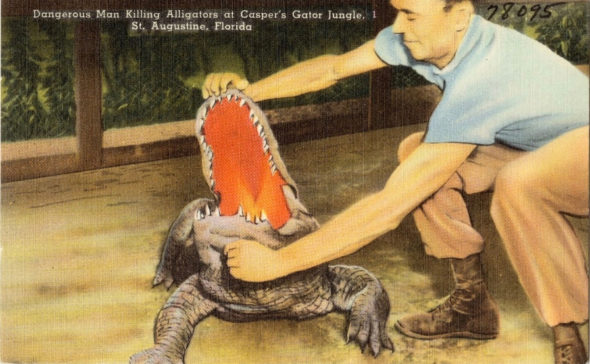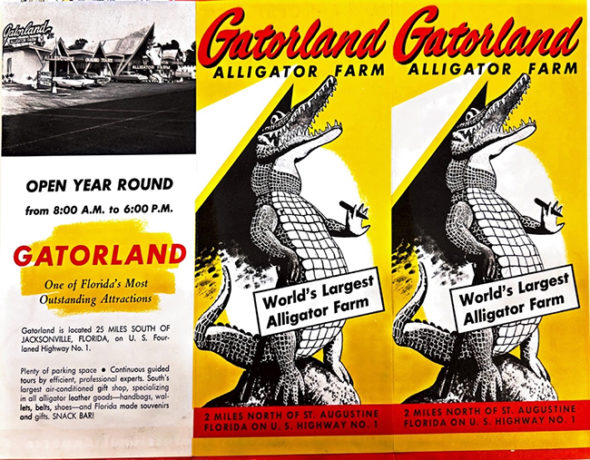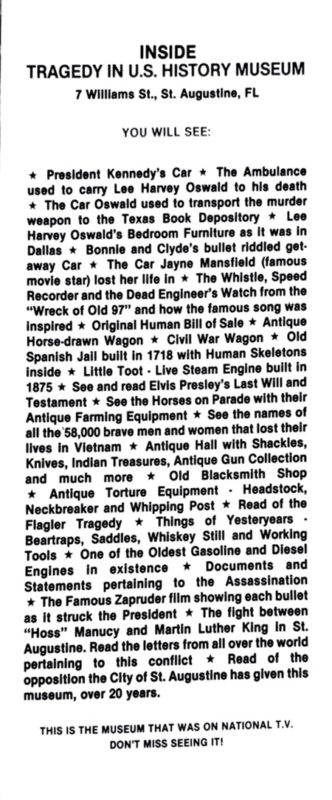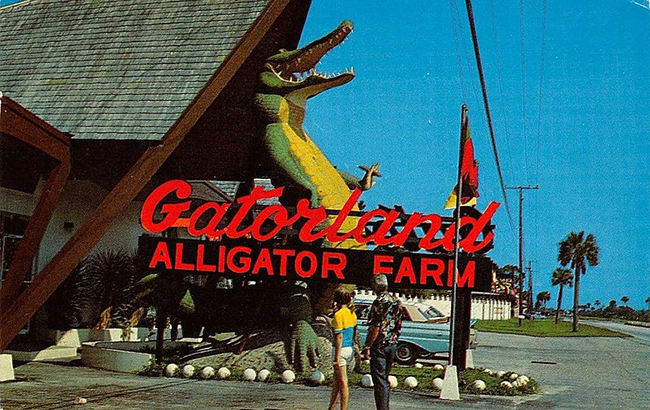By Presleigh Johnson
Public History is everywhere. Whether it’s signs all over St. Augustine, reenactments, or surf culture exhibits, the Oldest City is a treasure trove of history. Being a Flagler College student is one of the best ways to learn about the St. Augustine community.
Alligators. Oranges. Sunny beaches. Spanish history. These images instantly fill your mind when you imagine Florida, or at least they do for me. They also filled some of the minds of 20th century tourists to the Sunshine State.
When I first came to St. Augustine, I experienced the city by buying colorful ice cream, seeing the Castillo de San Marcos and walking along St. George Street. These experiences are common ways tourists enjoy what the city has to offer. History and entertainment seem fused together in the Oldest City.
Even though it seems like this city never runs out of something to see, many attractions that reflect St. Augustine’s wild, wacky history have long disappeared and remain largely forgotten.
With the rise of automobile travel and road trips in the 20th century, attractions ranging from roadside zoos to citrus stands dotted the state — experiences that might be summed up as “Florida Kitsch.” A1A and U.S. 1 were two highways known for their kitschy, fun attractions.

Roadside attractions and themed tourist experiences have been a statewide tradition for decades and St. Augustine has been no exception, having its fair share of eccentric entertainment. From ostrich encounters to tragic tales, there was plenty to keep tourists entertained in the Oldest City.
Reflecting the growing appeal of automobile-themed activities, Jim Casper opened the Parking Palace Theatre in 1935 as St. Augustine’s first drive-in theater, screening all different types of films. He also opened Casper’s Ostrich and Alligator Farm in 1946, which boasted of 8,000 alligators and an ostrich race track. Yes, a 1/8-mile race track for ostriches. Young children could even hold ostrich eggs.

A giant alligator statue greeted visitors as they walked in to see flamingos, snakes, a giant porcupine, and more. Brochures claimed it was not just the state’s largest alligator farm, but the largest in the world. Casper’s Ostrich and Alligator Farm later became known as “Gatorland” until it closed in the late 1980s. Leaders in the tourism industry were able to tap into Florida’s natural environment as a setting for exotic animal encounters.
St. Augustine attractions weren’t all about alligators and animals, flora and fauna. A private collection, the Rose Museum welcomed downtown tourists to see a broad range of rose-themed items, including coins, china, and lace. Opening in 1955, the Rose Museum claimed to be a one-of-a-kind-experience on St. George Street, comparing the long history of roses with the long history of St. Augustine.
For some, personal hobbies might involve traveling, gardening, or chess, but for Charles Perry, it was creating a park for his half-sized steam train. In 1963, he opened up the Florida Southwestern Railway, moving his train to land on State Road 16. Tourists driving down the road could stop and pay 50¢ to ride the train on a circular track, then grab a burger.

History and the macabre seemed to interest locals opening themed museums. At Tragedy in U.S. History Museum, visitors could see cars associated with the John F. Kennedy assassination, along with a version of Elvis Presley’s will, and artifacts associated with torture. Other cars connected to fatal car crashes were also on display. Opening in 1965, the museum operated for more than thirty years before closing its doors.


Following a similar theme, the Museum of Weapons and Early American History opened on Spanish Street in the 1980s. Visitors could see a variety of historical weapons across different wars and centuries.
Tourist attractions and entertaining museums of by-gone eras remind us that Florida has served as a land of exploration. Roadside attractions were a “direct descendant” of 19th century cabinets of curiosity, says Bob Nawrocki, Chief Librarian of the St. Augustine Historical Society. To Nawrocki, “The sideshows of the traveling carnival era were a way of entertaining people with the strange and the exotic … In St. Augustine, the roadside attractions presented an opportunity for people to entertain people or share their collections with others.”
While none of these sites are here today, they reflect the many tastes of enthusiastic collectors, hoping to display their personal interests to a growing community of Florida travelers. St. Augustine, as a city with a storied past, has been home to some of the most random and wild attractions in the state.
Different highway routes changed over time and so did the nature of Florida tourism, shifting away from road trips to final destinations, especially theme parks. Even so, the Oldest City’s history and landscape continually remain an appealing backdrop to showcase experiences founded on natural environments, novelty and nostalgia.
Remembering these tourist experiences helps share the unique cultural legacy of fun-filled memories this state has given to tourists across the country and around the world.
Click here to check out the St. Augustine Historical Society’s online collection.
Click here to browse more of Florida’s roadside attractions.




Be the first to comment on "Florida Kitsch: The Wild World of St. Augustine Tourist Attractions"